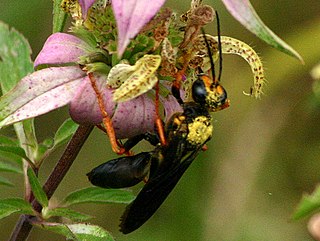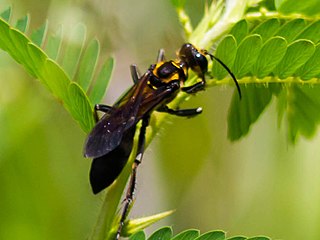
The Bembicini, or sand wasps, are a large tribe of bembecid wasps, comprising 20 genera. Bembicines are predators on various groups of insects. The type of prey captured tends to be rather consistent within each genus, with flies (Diptera) being the most common type of prey taken. Nests are typically short, simple burrows, with a single enlarged chamber at the bottom which is stocked with freshly paralysed prey items for the developing wasp larva; the egg may sometimes be laid before the chamber is completely stocked. It is common for numerous females to excavate nests within a small area where the soil is suitable, creating large and sometimes very dense nesting aggregations, which tend to attract various species of parasitic flies and wasps, many of which are cleptoparasites; in some cases, the sand wasps prey on their own parasites (e.g.,), a surprisingly rare phenomenon in the animal kingdom. Although sand wasps are normally yellow and black, some are black and white with bright green eyes.

Sphex flavovestitus is a species of thread-waisted wasp in the family Sphecidae.

Podium luctuosum is a species of thread-waisted wasp in the family Sphecidae. It is known to provide Parcoblatta as prey for its larvae.
Glenostictia is a genus of sand wasps in the family Bembicidae. There are more than 20 described species in Glenostictia.
Podalonia argentifrons is a species of thread-waisted wasp in the family Sphecidae.
Isodontia apicalis is a species of thread-waisted wasp in the family Sphecidae from North and Central America.

Isodontia philadelphica is a species of thread-waisted wasp in the family Sphecidae.

Ammophila nigricans is a species of thread-waisted wasp in the family Sphecidae.

Sphex ashmeadi is a species of thread-waisted wasp in the family Sphecidae.

Ammophila wrightii is a species of thread-waisted wasp in the family Sphecidae.

Chalybion zimmermanni, known generally as the Zimmermann's mud wasp or blue mud dauber wasp, is a species of thread-waisted wasp in the family Sphecidae.
Sphex texanus is a species of thread-waisted wasp in the family Sphecidae.
Prionyx canadensis is a species of thread-waisted wasp in the family Sphecidae.

Sphex habenus is a species of thread-waisted wasp in the family Sphecidae.

Prionyx foxi is a species of thread-waisted wasp in the family Sphecidae.
Podalonia luctuosa is a species of thread-waisted wasp in the family Sphecidae.

Prionyx parkeri is a species of thread-waisted wasp in the family Sphecidae.
Palmodes praestans is a species of thread-waisted wasp in the family Sphecidae.

Sphex lucae is a species of thread-waisted wasp in the family Sphecidae. Sphex lucae is predominantly found in western North America, but specimens have also been collected in Georgia and Florida.Entomologist Henry T. Fernald described this wasp as: "Body rather slender; the head and thorax black; the abdomen black to red, the two colors variously mingled in different examples, the males being generally much darker than the females; wings varying from yellowish hyaline with a fuliginous tinge to deep fuliginous with a violet reflection; legs dark ferruginous to black." Richard M. Bohart and Arnold S. Menke proposed moving this wasp to the monotypic genus Fernaldina. The main body of research on this wasp prior to 1965 regarded its propensity for communal roosting on plants.

Chlorion cyaneum, the purplish-blue cricket hunter, is a species of thread-waisted wasp in the family Sphecidae.












